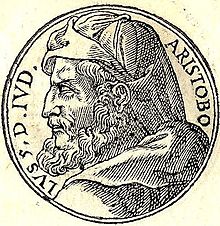Yudas Aristoboulos
Yudas Aristoboulos I /ˌærɪstəˈbjuːləs/ (bahasa Yunani: Ἰούδας Ἀριστόβουλος Ioúdās Aristóboulos, julukan yang berarti "nasihat terbaik";[2] bertakhta skt. 104 – 103 SM[3]) merupakan penguasa pertama Hashmonayim yang menyatakan dirinya sendiri "raja". Ia merupakan putra sulung dari kelima putra Yohanes Hyrkanos, pemimpin terdahulu.[4][5]
| Aristobulus I | |
|---|---|
| Raja dan Imam Tinggi Yudea | |
 Aristobulus I dari Promptuarium Iconum Insigniorum Guillaume Rouillé | |
| Berkuasa | skt. 104–103 SM (1 tahun)[1] |
| Pendahulu | Yohanes Hyrkanos, pemimpin Makabe |
| Penerus | Aleksander Ianneus |
| Kematian | skt. 103 SM |
| Pasangan | Salome Aleksandra |
| Dinasti | Hashmonayim |
| Ayah | Yohanes Hyrkanos I |
| Agama | Yudaisme Helenistik |
Aristoboulos bukan hanya raja pertama dari garis Hashmonayim, tetapi yang pertama dari semua raja Ibrani yang mendapatkan baik gelar imamat dan raja. Saduki dan Eseni tidak peduli dengan Aristoboulos yang memegang gelar raja, tetapi Farisi tidak senang: mereka merasa bahwa kerajaan itu hanya dapat dipegang oleh keturunan Daud (orang-orang Hashmonayim adalah Suku Lewi). Orang-orang Farisi memulai pemberontakan besar-besaran, tetapi Aristoboulos meninggal sebelum usaha untuk menggulingkannya terjadi.[6]
Silsilah
suntingLihat pula
suntingCatatan
suntingKutipan
sunting- ^ Rocca 2009, hlm. 6.
- ^ Elwell & Comfort 2001, hlm. 109.
- ^ Baskin 2011, hlm. 221.
- ^ Brisco 1999.
- ^ Ellens & Greene 2009, hlm. 205.
- ^ Wine 2012, hlm. 174.
Bibliografi
sunting- Baskin, Judith R. (2011). The Cambridge Dictionary of Judaism and Jewish Culture. Cambridge University Press. ISBN 9780521825979.
- Brisco, Thomas V. (1999). Holman Bible Atlas. B&H Publishing Group. ISBN 9781433670312.
- Buth, Randall; Notley, R. Steven (2013). The Language Environment of First Century Judaea: Jerusalem Studies in the Synoptic Gospels. BRILL. ISBN 9789004264410.
- Ellens, J. Harold; Greene, John T. (2009). Probing the Frontiers of Biblical Studies. Wipf and Stock Publishers. ISBN 9781606084601.
- Elwell, Walter A.; Comfort, Philip Wesley (2001). Tyndale Bible Dictionary. Tyndale House Publishers. ISBN 9780842370899.
- Regev, Eyal (2013). The Hasmoneans: Ideology, Archaeology, Identity. Vandenhoeck & Ruprecht. ISBN 9783525550434.
- Freedman, David Noel; Myers, Allen C. (2000). Eerdmans Dictionary of the Bible. Amsterdam University Press. ISBN 9789053565032.
- Horbury, William; Davies, W. D.; Finkelstein, Louis; Sturdy, John (1999). The Cambridge History of Judaism. Cambridge University Press. ISBN 9780521243773.
- Losch, Richard R. (2008). All the People in the Bible: An A-Z Guide to the Saints, Scoundrels, and Other Characters in Scripture. Wm. B. Eerdmans Publishing. ISBN 9780802824547.
- Magness, Jodi (2012). The Archaeology of the Holy Land: From the Destruction of Solomon's Temple to the Muslim Conquest. Cambridge University Press. ISBN 9780521124133.
- Marshak, Adam Kolman (2015). The Many Faces of Herod the Great. Wm. B. Eerdmans Publishing. ISBN 9780802866059.
- Metzger, Bruce Manning; Coogan, Michael David (2004). The Oxford Guide to People & Places of the Bible. Oxford University Press. ISBN 9780195176100.
- Myers, E. A. (2010). The Ituraeans and the Roman Near East: Reassessing the Sources. Cambridge University Press. ISBN 9781139484817.
- Nickelsburg, George W. E.; Neusner, Jacob; Avery-Peck, Alan Jeffery (2003). George W.E. Nickelsburg in Perspective: An Ongoing Dialogue of Learning. BRILL. ISBN 9789004129863.
- Rocca, Samuel (2009). The Army of Herod the Great. Osprey Publishing. ISBN 9781846032066.[pranala nonaktif permanen]
- Sayles, Wayne G. (1999). Ancient Coin Collecting VI: Non-Classical Cultures. F+W Media. ISBN 9780873417532.[pranala nonaktif permanen]
- Wine, Sherwin T. (2012). A Provocative People: A Secular History of the Jews. IISHJ-NA. ISBN 9780985151607.
Pranala luar
sunting- Jewish Encyclopedia "Aristobulus I"
- Catholic Online "The Machabees"